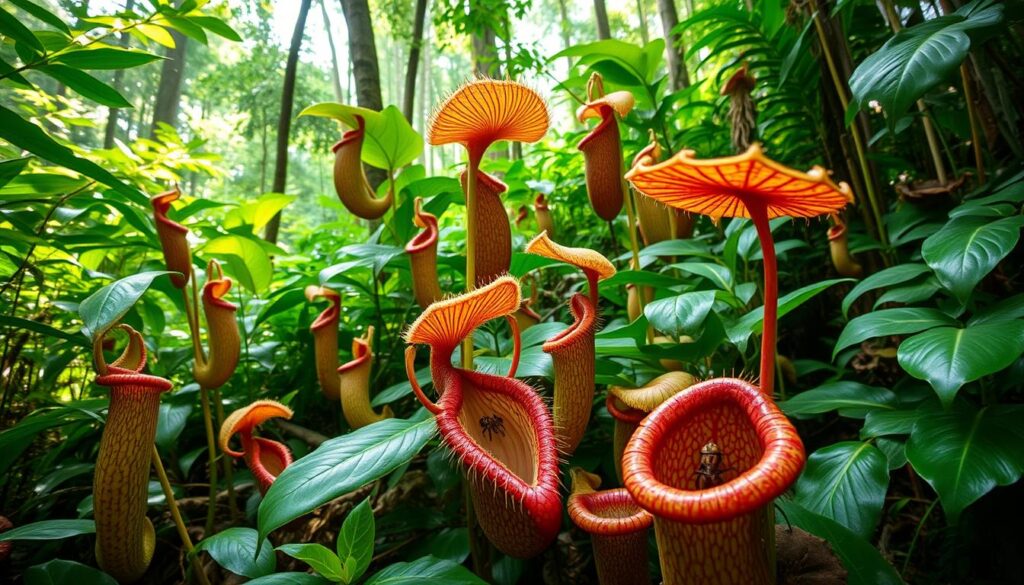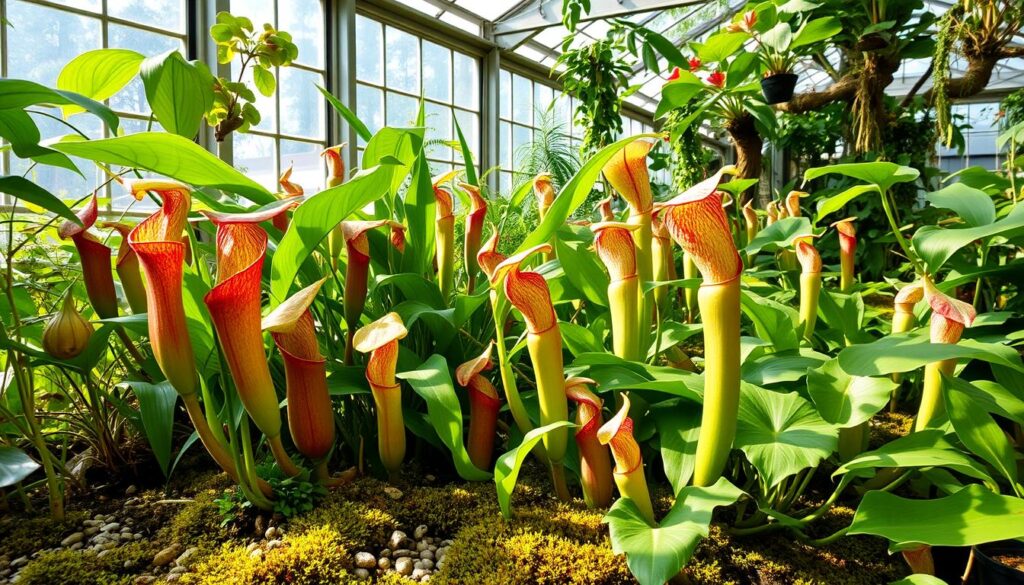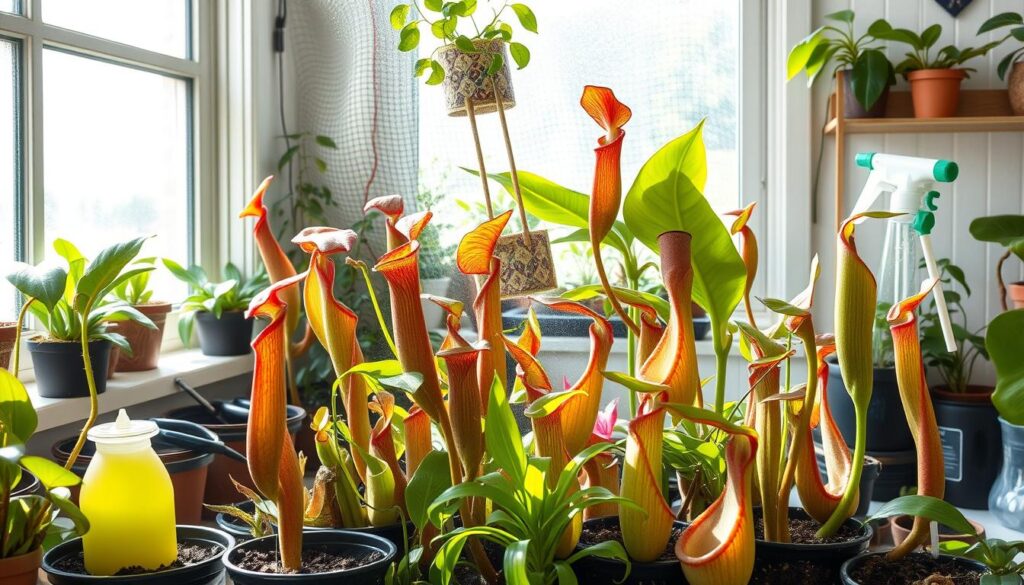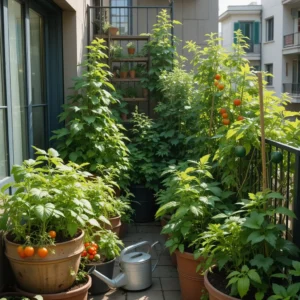Pitcher plants are a type of carnivorous plant that capture and digest insects for nutrients. They are found in over 100 species worldwide, including Asia, Australia, and North America. These plants thrive in areas where soil lacks nutrients.
Carnivorous plants, like pitcher plants, capture and digest insects to get nutrients. This makes them a favorite among plant lovers and scientists. Let’s explore the amazing facts about these unique plants.
The Fascinating World of Pitcher Plants
Pitcher plants are truly unique, capturing and digesting insects to get nutrients. Their evolution is complex, leading to special leaves and digestive enzymes. Knowing about these plants is key for both enthusiasts and scientists.
Each pitcher plant species has its own care needs. For example, nepenthes need high humidity and warm temperatures. By learning about different genera, like Sarracenia and Nepenthes, we can better care for our plants.
Evolution of Carnivorous Plants
The evolution of carnivorous plants is fascinating. It has given them unique features like modified leaves and digestive enzymes. This adaptation helps them survive in poor soil where others can’t.
Natural Distribution Worldwide
Pitcher plants live in many places, including tropical and subtropical areas. They are found in countries like Malaysia, Indonesia, and the Philippines. These plants thrive in the wild in these regions.
Different Genera of Pitcher Plants
There are many genera of pitcher plants, each with its own traits. Common ones include Nepenthes, Sarracenia, and Darlingtonia. Knowing about these genera helps us understand and care for each species better.
How Pitcher Plants Trap Their Prey
Pitcher plants have special features to catch and digest insects. This helps them grow well in poor soil. They need insects, which are drawn to the plant’s sweet, sticky liquid. This liquid, called nectar, is key to their pitcher plant feeding habits.
The leaves of pitcher plants form a deep cup or pitcher. This cup traps insects. Once an insect falls in, it can’t get out because of the leaf’s smooth, waxy surface. The plant then digests the insect with enzymes, getting the nutrients it needs.

- A deep, cupped leaf structure that forms a pitcher
- A sweet, sticky liquid that attracts insects
- A smooth, waxy surface that prevents insects from escaping
- Enzymes that digest the insects, providing essential nutrients
These features help pitcher plants catch and digest insects efficiently. This allows them to thrive in many different places.
The Unique Digestive System of Pitcher Plants
Pitcher plants have a special way to digest food in poor soil. When growing pitcher plants, knowing how they digest is key for pitcher plant care tips. Their digestive system uses enzymes and works with other living things.
Enzymatic Processes
The plant makes enzymes to break down insect proteins and nutrients. These enzymes are crucial for the plant’s growth and survival.
Nutrient Absorption Methods
Pitcher plants also have special ways to absorb nutrients. Their leaves form a cup that traps insects. The plant’s enzymes then digest them, and the plant absorbs the nutrient-rich liquid.

Symbiotic Relationships
Pitcher plants also work with bacteria and fungi. These partnerships help break down insects and organic matter. This is vital for the plant’s digestion.
Understanding pitcher plants’ digestive system helps in caring for them. Whether indoors or outdoors, mimicking their natural environment is crucial. This ensures they get the nutrients they need to grow well.
Amazing Adaptations for Survival
Carnivorous plants, like pitcher plants, have special ways to survive where nutrients are scarce. Their leaves form a deep, slippery cup to trap insects. This cup helps them get nutrients like nitrogen and phosphorus from the soil.
Pitcher plants can make digestive enzymes to break down insects. These enzymes are like those in animals, helping plants get nutrients from their prey. They also have toxic compounds to keep animals from eating them.
Some of the amazing adaptations of pitcher plants include:
- Modified leaves that form a deep, slippery cup to trap insects
- Production of digestive enzymes to break down captured prey
- Development of toxic compounds to deter herbivores and predators

These special features help pitcher plants live in many places, from bogs to rocky areas. They are key players in their ecosystems, showing the amazing diversity of plant life.
| Plant Species | Native Habitat | Unique Adaptations |
|---|---|---|
| Pitcher Plant (Nepenthes) | Tropical forests and bogs | Modified leaves, digestive enzymes, toxic compounds |
| Sundew (Drosera) | Bogs and swamps | Sticky leaves, digestive enzymes, carnivorous diet |
| Venus Flytrap (Dionaea) | Bogs and swamps | Modified leaves, trigger hairs, digestive enzymes |
The Role of Pitcher Plants in Ecosystems
Pitcher plants are key to keeping ecosystems in balance. They live in poor soil areas and have special features. Each pitcher plant species fits into its own environment, needing specific pitcher plant habitat requirements.
These plants are a food source for many animals. They catch and digest insects, controlling local insect populations. They also host bacteria and spiders, helping break down trapped insects.

The ecological importance of pitcher plants is huge. They keep ecosystems diverse and show the health of an area. Studying them helps scientists understand species and environment relationships.
- Pitcher plants provide a source of food for other animals
- They help to regulate local insect populations
- They support a range of other organisms, from bacteria to spiders
In summary, pitcher plants are vital for ecosystem balance. Knowing about pitcher plant species and their pitcher plant habitat requirements helps us appreciate species and environment connections.
| Pitcher Plant Species | Habitat Requirements | Ecological Importance |
|---|---|---|
| Nepenthes | Tropical forests | Regulates insect populations |
| Sarracenia | Bogs and swamps | Supports diverse range of organisms |
Growing Pitcher Plants at Home
For those who love unique plants, growing pitcher plants can be very rewarding. With the right conditions and pitcher plant care tips, these plants can do well at home. They need high humidity, full sun to partial shade, and poor soil to thrive.
It’s important to give them the nutrients they need. Since they get nutrients by eating insects, you should sometimes add extra food. Here are some pitcher plant care tips to remember:
- Use distilled or rainwater to prevent mineral buildup
- Provide a mix of peat moss and perlite for optimal drainage
- Avoid fertilizing, as this can harm the plant
By following these tips and understanding what growing pitcher plants need, you can enjoy having them at home. With the right care, pitcher plant care tips can help keep these plants healthy and long-lived.
| Plant Species | Optimal Temperature | Humidity Level |
|---|---|---|
| Nepenthes | 65-85°F (18-30°C) | 40-60% |
| Sarracenia | 55-75°F (13-24°C) | 30-50% |
Common Pitcher Plant Species and Their Characteristics
Pitcher plants are fascinating and popular among plant lovers. Each species has its own needs for care. Nepenthes, for example, is known for its tall, slender pitchers.
Pitcher plants capture and digest insects to get nutrients. This is because they live in poor soil. Nepenthes, for instance, has slippery pitchers to trap insects.
Nepenthes Species
Nepenthes plants live in the tropics and have pitchers up to 3 feet tall. They need high humidity and full sun to partial shade. Popular species include nepenthes alata and nepenthes ventricosa.

Sarracenia Varieties
Sarracenia plants have colorful, trumpet-shaped pitchers. They are from North America and need different care than nepenthes. Popular varieties include sarracenia purpurea and sarracenia leucophylla.
Knowing each pitcher plant’s needs helps them thrive. Whether you want to grow nepenthes or sarracenia, learning about them is key to successful care.
Essential Care Requirements
To keep your pitcher plant thriving, it’s crucial to understand the essential pitcher plant care requirements. These unique plants demand specific conditions. They need high humidity, bright light, and a diet of insects. By replicating their natural pitcher plant habitat requirements, you can create an ideal environment for your plant to flourish.
Here are the key elements to focus on:
- Lighting: Provide bright, indirect light to mimic the plant’s natural habitat.
- Water: Use distilled or rainwater, and maintain a consistent level of moisture.
- Nutrients: Supplement with insects, such as flies or spiders, to support the plant’s carnivorous diet.
By following these guidelines and understanding the specific pitcher plant care needs, you can help your plant thrive. Remember to research and stay up-to-date on the latest pitcher plant habitat requirements. This ensures you’re providing the best possible environment for your unique plant.
| Factor | Requirement |
|---|---|
| Humidity | 40-60% |
| Temperature | 65-85°F (18-30°C) |
| Light | Bright, indirect |
Understanding Pitcher Plant Feeding Habits
Pitcher plants capture and digest insects to get nutrients. This is key for their survival. They naturally eat insects like flies, spiders, beetles, and ants.
If you want to grow pitcher plants, mimic their natural diet. Create a good environment and feed them the right insects. A balanced diet helps them grow well.
Some important tips for pitcher plant feeding are:
- Use water low in minerals for them.
- Give them different insects for a balanced diet.
- Don’t use fertilizers, as they can harm the plants.
Knowing how pitcher plants eat and giving them the right food helps. This way, you can grow pitcher plants successfully and enjoy their unique features.

Pitcher plants get nutrients from insects because their soil is poor. By mimicking their natural conditions and feeding them the right insects, you can create a perfect home for them.
| Pitcher Plant Species | Natural Prey Types | Supplemental Feeding Guidelines |
|---|---|---|
| Nepenthes | Flies, spiders, beetles | Provide a variety of insects, avoid fertilizers |
| Sarracenia | Flies, ants, bees | Offer a source of water low in minerals, supplement with insects |
Myths and Misconceptions About Pitcher Plants
Pitcher plants, a type of carnivorous plants, have long fascinated many. Yet, myths and misconceptions surround them. One myth is that they are hard to care for. But, with the right care, they are quite easy to maintain.
Some common myths and misconceptions about pitcher plants include:
- They are poisonous to humans and pets
- They require a lot of direct sunlight
- They need to be fed constantly
In truth, pitcher plants are not poisonous. They can grow well in different light conditions. They also don’t need constant feeding. They get nutrients from the soil and insects they catch. By clearing up these myths, we can better appreciate pitcher plants and other carnivorous plants.

Conservation Status and Future Challenges
Pitcher plant species face many threats, mainly from habitat loss and degradation. Their habitat needs are very specific. This has led to a big drop in their numbers. Now, many are considered threatened or endangered, showing the urgent need for conservation.
Habitat loss affects pitcher plants in many ways. It cuts down their growing space and messes up their ecosystem. Conservation efforts are key to save what’s left. Some groups are working to create protected areas and promote green land use.

- Research and monitoring of pitcher plant populations
- Establishment of protected areas and nature reserves
- Education and outreach programs to raise awareness about the importance of conservation
- Collaboration with local communities to develop sustainable land-use practices
These actions aim to tackle the big problems facing pitcher plants. They hope to ensure these plants can thrive for a long time.
| Pitcher Plant Species | Conservation Status | Habitat Requirements |
|---|---|---|
| Nepenthes | Threatened | Tropical forests |
| Sarracenia | Endangered | Bogs and savannas |
Pitcher plants are truly fascinating and unique. They offer many benefits to both plant lovers and scientists. These plants have learned to survive in poor soil by catching and digesting insects.
By understanding pitcher plants, we can help protect them for the future. This is important for all of us.
Pitcher plants are key to their ecosystems. They help keep their environments balanced. Losing them could have big effects.
Learning about these plants shows us why conservation is so important. We must protect pitcher plants and their homes.
In the United States, many gardens and groups are working to save pitcher plants. Your support can help these efforts. This ensures these amazing plants will thrive for years to come.
Whether you’re a botany expert or new to pitcher plants, they are truly captivating. Their importance cannot be overstated.
FAQ
What are pitcher plants and how do they obtain their nutrients?
Pitcher plants are special plants that eat insects to get nutrients. They have leaves shaped like cups that trap insects. Inside these cups, there’s a sweet liquid that draws insects in.
What are the different genera of pitcher plants?
There are many types of pitcher plants, like Nepenthes and Sarracenia. Each type has its own look and needs. Knowing about these differences helps plant lovers learn more about these plants.
What are the essential care requirements for pitcher plants?
Pitcher plants need high humidity, lots of light, and insects to eat. They also need careful watering and food to stay healthy.
How do pitcher plants trap their prey?
Pitcher plants catch insects with their special leaves and digestive juices. The leaves form a cup that’s filled with a sweet liquid. This liquid attracts insects, and the juices break down their bodies for nutrients.
What is the role of pitcher plants in ecosystems?
Pitcher plants are important in nature. They feed other animals and help control insect numbers. They also add to the variety of ecosystems, showing how plants can adapt.
How can I grow pitcher plants at home?
To grow pitcher plants at home, you need to meet their specific needs. This includes keeping the air humid, providing bright light, and feeding them insects. You also need the right soil and watering to help them thrive.
What are some common pitcher plant species and their characteristics?
Some well-known pitcher plants are Nepenthes and Sarracenia. Each has its own look and care needs. Knowing these helps plant lovers grow and care for them.
What are the conservation status and future challenges facing pitcher plants?
Many pitcher plants are in danger because of lost habitats and pollution. We need to protect these plants. By understanding their situation, we can work together to save them.
How do I feed my pitcher plant?
You can feed your pitcher plant with live insects or special plant food. It’s important to know what your plant needs to stay healthy.
What are some common myths and misconceptions about pitcher plants?
Some people think pitcher plants are hard to care for or poisonous. But they’re actually easy to care for and safe. They make great additions to any plant collection.






One thought on “10 Amazing Facts About Pitcher Plants You Need To Know”